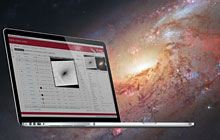Editorial
It is with a feeling of (almost) spring in the air, and eagerly awaiting a warmer season, that we look at the accomplishments of the past months. Many things have happened since our last newsletter. First, the Space Telescope Science Institute (STScI) has a new Director, Ken Sembach. I sat down with Ken recently and asked him about his first impressions of his new “life” and you can find the interview here.
Hubble is going stronger than ever. The spacecraft is doing well (touch wood), the instruments are behaving well and your collective interest is very high! Since last year, we have introduced the Mid-Cycle Proposals as an opportunity to propose for time to observe recently discovered, non-transient objects. Applicants are required to explain why such proposals could not have been submitted by the previous cycle deadline and to provide a description of the scientific urgency of the observations.
1 October 2015 was the deadline for the first set of Cycle 23 Mid-Cycle Proposals. A total of 45 proposals requesting 175 orbits were received and reviewed by previous Time Allocation Committee members. I am pleased to say that ESA member states’ PIs were again very successful in this selection, accounting for 54% of the successful proposals and 62% of the available orbits.
Now that you are all busy writing your best proposals for Cycle 24 (deadline: 8 April!) remember to be bold in your thinking: this has greatly paid off in the recent cycles. Please also remember that there are special initiatives to take advantage of. The Ultraviolet Initiative continues to run and you are all encouraged to start thinking about observations in preparation for JWST. You can find all details here.
I will write about the results from the Cycle 24 call in a future Hubble newsletter, but in the meantime, do remember that you have three representatives on the Space Telescope Users Committee (STUC), who are eager to hear from you, and to represent your views on the committee. The STUC advises the STScI Director from the user's perspective on the scientific operations of the Hubble mission, and recommends changes and procedures to maximise your collective scientific productivity. You can find here a special message from your three representatives, who are very interested to engage you all in a conversation about the best scientific exploitation of the Hubble observatory.
Finally, from this issue forwards, we are going to regularly devote some space in our newsletter to keeping you informed of what is happening with eHST, the European Hubble Archive, which is available for you to browse and use.
Best of luck with your Cycle 24 proposals!
Contacts
Antonella Nota
ESA HST Project Scientist, STScI
Email: hubblenewseurope@stsci.edu

|
9 March 2016: Before becoming Space Telescope Science Institute (STScI) Director Ken Sembach had already been heavily involved with science operations for the NASA/ESA Hubble Space Telescope for many years. At STScI he served as Hubble Project Scientist, Hubble Mission Head, and most recently as Interim Deputy Director. Previously, from 1992 to 1995, Ken Sembach was the Far Ultraviolet Spectroscopic Explorer (FUSE ...
|
| Read more |

|
9 March 2016: Since its launch, the Hubble Space Telescope has enjoyed a close relationship with its community of users through a variety of mechanisms: newsletters, surveys, ad-hoc working groups. In this context, the Space Telescope User Committee (STUC), continues to provide sound advice on Hubble science operations and observing policies.
Having celebrated the Hubble 25th anniversary last year, we also understand that ...
|
| Read more |

|
9 March 2016: Three members of the Space Telescope User Committee (STUC) are currently appointed by ESA: Stephane Charlot (France), Søren Larsen (The Netherlands) and David Sing (UK). They each bring unique scientific expertise and they all want to hear from you.
David Sing is an Associate Professor of Astrophysics at the University of Exeter. His speciality is atmospheric characterization of transiting exoplanets ...
|
| Read more |

|
9 March 2016: Since the first release of the new European Hubble Science Archive (eHST) in October 2015 (see the announcement in the previous ESA/Hubble Science Newsletter), development has continued and the next major release is planned for Summer 2016. This release will include the integration of the Hubble Source Catalog with advanced catalogue visualisation features. In particular, the development team is ...
|
| Read more |